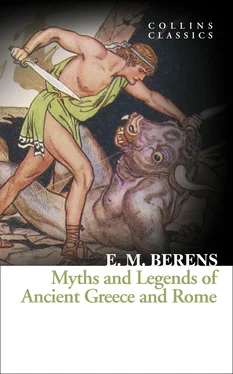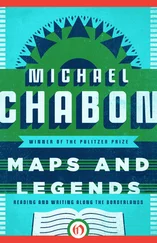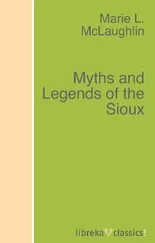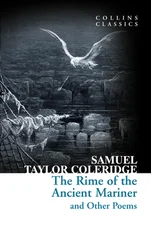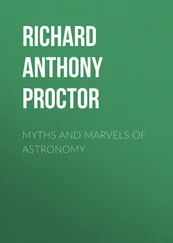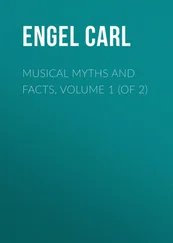MYTHS AND LEGENDS OF ANCIENT GREECE AND ROME
E. M. Berens
William Collins
An imprint of HarperCollins Publishers
1 London Bridge Street
London SE1 9GF
www.WilliamCollinsBooks.com
This eBook published in Great Britain by William Collins in 2016
Life & Times section © HarperCollins Publishers Ltd
Silvia Crompton asserts her moral rights as author of the Life & Times section
Classic Literature: Words and Phrases adapted from Collins English Dictionary
Cover by e-Digital Design
Cover illustration: Theseus slays the Minotaur in the labyrinth below the palace of King Minos , H M Brock/Mullan Collection/Mary Evans
A catalogue record for this book is available from the British Library
All rights reserved under International and Pan-American Copyright Conventions. By payment of the required fees, you have been granted the non-exclusive, non-transferable right to access and read the text of this e-book on-screen. No part of this text may be reproduced, transmitted, down-loaded, decompiled, reverse engineered, or stored in or introduced into any information storage and retrieval system, in any form or by any means, whether electronic or mechanical, now known or hereinafter invented, without the express written permission of HarperCollins
Source ISBN: 9780008180553
Ebook Edition © September 2016 ISBN: 9780008180560
Version: 2016-09-23
Contents
Cover
Title Page
Copyright
History of William Collins
Preface
PART I.—MYTHS.
Introduction
FIRST DYNASTY. ORIGIN OF THE WORLD—
URANUS AND GÆA (Cœlus and Terra)
SECOND DYNASTY.
CRONUS (Saturn)
RHEA (Ops)
DIVISION OF THE WORLD
THEORIES AS TO THE ORIGIN OF MAN
THIRD DYNASTY. OLYMPIAN DIVINITIES—
ZEUS (Jupiter)
HERA (Juno)
PALLAS-ATHENE (Minerva)
THEMIS
HESTIA (Vesta)
DEMETER (Ceres)
APHRODITE (Venus)
HELIOS (Sol)
EOS (Aurora)
PHŒBUS-APOLLO
HECATE
SELENE (Luna)
ARTEMIS (Diana)
HEPHÆSTUS (Vulcan)
POSEIDON (Neptune)
SEA DIVINITIES—
OCEANUS
NEREUS
PROTEUS
TRITON AND THE TRITONS
GLAUCUS
THETIS
THAUMAS, PHORCYS, AND CETO
LEUCOTHEA
THE SIRENS
ARES (Mars)
NIKE (Victoria)
HERMES (Mercury)
DIONYSUS (Bacchus or Liber)
AÏDES (Pluto)
PLUTUS
MINOR DIVINITIES—
THE HARPIES
ERINYES, EUMENIDES (Furiæ, Diræ)
MOIRÆ OR FATES (Parcæ)
NEMESIS
NIGHT AND HER CHILDREN—
NYX (Nox)
THANATOS (Mors), HYPNUS (Somnus)
MORPHEUS
THE GORGONS
GRÆÆ
SPHINX
TYCHE (Fortuna) and ANANKE (Necessitas)
KER
ATE
MOMUS
EROS (Cupid, Amor) and PSYCHE
HYMEN
IRIS
HEBE (Juventas)
GANYMEDES
THE MUSES
PEGASUS
THE HESPERIDES
CHARITES OR GRACES
HORÆ (Seasons)
THE NYMPHS
WATER NYMPHS
DRYADES, OR TREE NYMPHS
NYMPHS OF THE VALLEYS AND MOUNTAINS
THE WINDS
PAN (Faunus)
THE SATYRS
PRIAPUS
ASCLEPIAS (Æsculapius)
ROMAN DIVINITIES—
JANUS
FLORA
ROBIGUS
POMONA
VERTUMNUS
PALES
PICUS
PICUMNUS AND PILUMNUS
SILVANUS
TERMINUS
CONSUS
LIBITINA
LAVERNA
COMUS
CAMENÆ
GENII
MANES
PENATES
PUBLIC WORSHIP OF THE ANCIENT GREEKS AND ROMANS—
TEMPLES
STATUES
ALTARS
PRIESTS
SACRIFICES
ORACLES
SOOTHSAYERS (Augurs)
FESTIVALS
GREEK FESTIVALS—
ELEUSINIAN MYSTERIES
THESMOPHORIA
DIONYSIA
PANATHENÆA
DAPHNEPHORIA
ROMAN FESTIVALS—
SATURNALIA
CEREALIA
VESTALIA
PART II. —LEGENDS.
CADMUS
PERSEUS
ION
DÆDALUS AND ICARUS
THE ARGONAUTS
PELOPS
HERACLES
BELLEROPHON
THESEUS
ŒDIPUS
THE SEVEN AGAINST THEBES
THE EPIGONI
ALCMÆON AND THE NECKLACE
THE HERACLIDÆ
THE SIEGE OF TROY
RETURN OF THE GREEKS FROM TROY
NOTES
CLASSIC LITERATURE: WORDS AND PHRASES
ABOUT THE PUBLISHER
History of William Collins
In 1819, millworker William Collins from Glasgow, Scotland, set up a company for printing and publishing pamphlets, sermons, hymn books and prayer books. That company was Collins and was to mark the birth of HarperCollins Publishers as we know it today. The long tradition of Collins dictionary publishing can be traced back to the first dictionary William co-published in 1825, Greek and English Lexicon . Indeed, from 1840 onwards, he began to produce illustrated dictionaries and even obtained a licence to print and publish the Bible.
Soon after, William published the first Collins novel; however, it was the time of the Long Depression, where harvests were poor, prices were high, potato crops had failed and violence was erupting in Europe. As a result, many factories across the country were forced to close down and William chose to retire in 1846, partly due to the hardships he was facing.
Aged 30, William’s son, William II, took over the business. A keen humanitarian with a warm heart and a generous spirit, William II was truly “Victorian” in his outlook. He introduced new, up-to-date steam presses and published affordable editions of Shakespeare’s works and The Pilgrim’s Progress , making them available to the masses for the first time.
A new demand for educational books meant that success came with the publication of travel books, scientific books, encyclopedias and dictionaries. This demand to be educated led to the later publication of atlases, and Collins also held the monopoly on scripture writing at the time.
In the 1860s Collins began to expand and diversify and the idea of “books for the millions” was developed, although the phrase wasn’t coined until 1907. Affordable editions of classical literature were published, and in 1903 Collins introduced 10 titles in their Collins Handy Illustrated Pocket Novels. These proved so popular that a few years later this had increased to an output of 50 volumes, selling nearly half a million in their year of publication. In the same year, The Everyman’s Library was also instituted, with the idea of publishing an affordable library of the most important classical works, biographies, religious and philosophical treatments, plays, poems, travel and adventure. This series eclipsed all competition at the time, and the introduction of paperback books in the 1950s helped to open that market and marked a high point in the industry.
HarperCollins is and has always been a champion of the classics, and the current Collins Classics series follows in this tradition – publishing classical literature that is affordable and available to all. Beautifully packaged, highly collectible, and intended to be reread and enjoyed at every opportunity.
The want of an interesting work on Greek and Roman mythology, suitable for the requirements of both boys and girls, has long been recognized by the principals of our advanced schools. The study of the classics themselves, even where the attainments of the pupil have rendered this feasible, has not been found altogether successful in giving to the student a clear and succinct idea of the religious beliefs of the ancients, and it has been suggested that a work which would so deal with the subject as to render it at once interesting and instructive would be hailed as a valuable introduction to the study of classic authors, and would be found to assist materially the labours of both master and pupil.
Читать дальше
